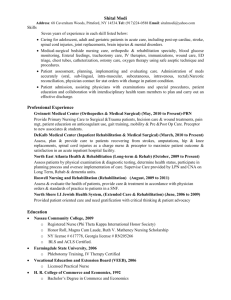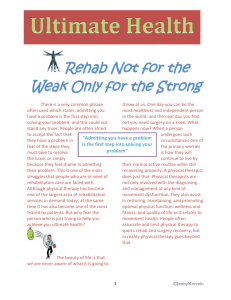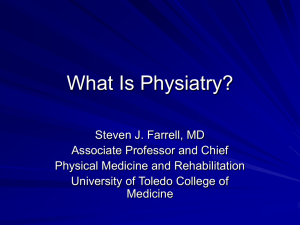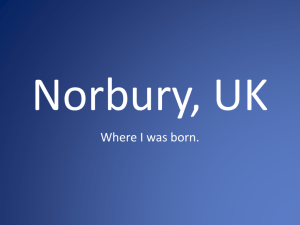Spotlight on Rehab - East Carolina University
advertisement
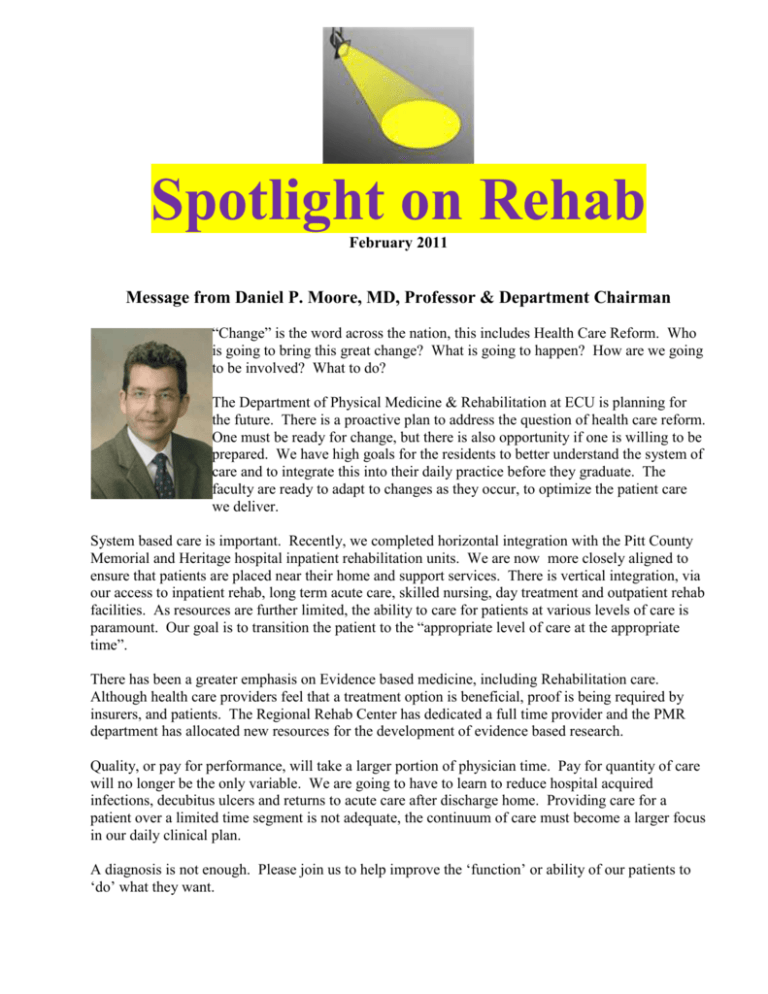
Spotlight on Rehab February 2011 Message from Daniel P. Moore, MD, Professor & Department Chairman “Change” is the word across the nation, this includes Health Care Reform. Who is going to bring this great change? What is going to happen? How are we going to be involved? What to do? The Department of Physical Medicine & Rehabilitation at ECU is planning for the future. There is a proactive plan to address the question of health care reform. One must be ready for change, but there is also opportunity if one is willing to be prepared. We have high goals for the residents to better understand the system of care and to integrate this into their daily practice before they graduate. The faculty are ready to adapt to changes as they occur, to optimize the patient care we deliver. System based care is important. Recently, we completed horizontal integration with the Pitt County Memorial and Heritage hospital inpatient rehabilitation units. We are now more closely aligned to ensure that patients are placed near their home and support services. There is vertical integration, via our access to inpatient rehab, long term acute care, skilled nursing, day treatment and outpatient rehab facilities. As resources are further limited, the ability to care for patients at various levels of care is paramount. Our goal is to transition the patient to the “appropriate level of care at the appropriate time”. There has been a greater emphasis on Evidence based medicine, including Rehabilitation care. Although health care providers feel that a treatment option is beneficial, proof is being required by insurers, and patients. The Regional Rehab Center has dedicated a full time provider and the PMR department has allocated new resources for the development of evidence based research. Quality, or pay for performance, will take a larger portion of physician time. Pay for quantity of care will no longer be the only variable. We are going to have to learn to reduce hospital acquired infections, decubitus ulcers and returns to acute care after discharge home. Providing care for a patient over a limited time segment is not adequate, the continuum of care must become a larger focus in our daily clinical plan. A diagnosis is not enough. Please join us to help improve the ‘function’ or ability of our patients to ‘do’ what they want. Daniel P. Moore, MD, Professor & Department Chairman Medical Director of Regional Rehabilitation Center Medical Director of Wound and Hyperbaric Center Board Certified, American Board of Physical Medicine & Rehabilitation Board Certified, Pain Medicine Board Certified, Pediatric Rehabilitation American Board of Neuromuscular and Electrodiagnostic Medicine Change is the Word With a new name and look for the paper and new faculty and staff for the department, 2011 is off to a great start. New Faculty John Norbury, MD Leo Villarosa, MD Don Macron, MD Dr. Norbury is a Clinical Assistant Professor and General Rehabilitation physician. He will be performing EMG/Botox procedures; Rehab Consults and Musculoskeletal Ultrasound. Dr. Villarosa is the Medical Director of Inpatient Rehabilitation at Heritage Hospital in Tarboro, NC. He is a Clinical assistant Professor in Musculoskeletal Medicine. Dr. Macron is a Clinical Assistant Professor and Interventional physician. He will be performing interventional procedures and EMG’s. New Staff Sandy Wynn - Clinical Administrative Manager. Her duties including personnel management of the administrative staff, budget development and management, financial reporting and analysis, new program implementation, sponsored and non-sponsored grants & research administration, coordination of capital equipment purchases and maintenance agreements. Barbara Bristow-Assistant to the Chair. Her duties are to assist Dr. Moore, manage calendars, contract billing, travel and Time and Effort Rose Jones - PM&R Administrative Support Associate. She is responsible for the clinical calendars, faculty leave request, purchasing, direct pays and Web on Call. Thayar Cofield- PCMH Administrative Support- She is responsible for the PCMH portion of the EMG billing, mail distribution, faxes, meeting preparations and Blackboard. New Clinic Openings Dr. Norbury started an Ultrasound Guided Injection Clinic at the Firetower Medical Office on October 13, 2010. He sees patients there every Wednesday morning. He also has a Botox/Spasticity clinic at the Physicians Rehab Clinic on the 2nd and 4th Thursday mornings. Dr. Villarosa is the Director of the Inpatient Rehabilitation Unit at Heritage Hospital in Tarboro, NC. He also has an EMG clinic in the Heritage Outpatient Center on the 2nd and 4th Thursday of each month. Dr. Macron will be seeing patients in the Musculoskeletal Spine Center at the ECU Neurosurgical Practice site. He will be performing interventional procedures in the 1st floor of the Moye Medical Center. Regional Rehabilitation Center introduces diagnostic and therapeutic selective motor nerve branch blocks into its spasticity management program The inpatient and outpatient spasticity management program is undertaking a new initiative to improve the quality of patient care. The center now provides patients with both diagnostic and therapeutic selective motor nerve branch blocks. Historically, the center has used phenol to inject mixed motor- sensory nerves in addition to the more common botulinum toxin treatments. Unfortunately, phenol carries the risk of paresthesias and botulinum often cannot provide enough reduction in tone for some patients. Additionally, both botulinum and phenol have effects which last for months to years, so the patient may have to wait for a long period of time for undesirable effects to wear off. By employing selective motor nerve branch blocks, which only target the motor nerve(s) to a given muscle, one can avoid the paresthesias that sometimes complicate phenol injections. The protocol includes giving a diagnostic bupivacaine injection so that the patient can work with the therapist to see if the procedure is successful. Once the therapeutic effect is confirmed, a more permanent phenol or botulinum injection can be performed. Additionally, EMG surface mapping is being used so that the nerve can be precisely localized in two dimensions prior to the use of either a therapeutic or diagnostic injections. This allows patients to undergo a procedure with a lot more comfort since one does not need to "dig around" with a needle in order to find the target nerve. This initiative was kicked off on November 17 when Mitchell Paulin, M.D. came from Philadelphia to the Regional Rehabilitation Center to give a presentation on selective motor nerve branch blocks. Dr. Paulin then worked in our spasticity clinic on a consultative basis to help us improve the program. "I think getting Dr. Paulin to come down and teach us these techniques in hands-on fashion was very helpful in terms of kicking off this program in the right way," says Dr. John Norbury, one of the physicians who specializes in spasticity management. Used thoughtfully in conjunction with other treatment options, diagnostic and therapeutic motor nerve blocks have already proven to be effective adjuncts for several of our patients with spasticity. By: Dr. Erwin Manalo and Dr. John Norbury CONGRATULATIONS TO THE NEW 2011/2012 CHIEF RESIDENTS!! Dr. Keith Foster-Administrative Chief Resident Dr. Stephanie Plummer-Academic Chief Resident Updates on PM&R Research “Emerging Strategies for Rehabilitation of the Stroke Patient” By John W Norbury MD, Brian P McDonald DO, John M Barbis MA, PT, Guy w Fried MD, Steven Mandel MD November/December 2009 Practical Neurology pg 17-21 “Spinal Orthoses in Rehabilitation” by Dr. Daniel Moore, Dr. Edward Tilley and Dr. Paul Sugg Physical Medicine and Rehabilitation by Randall L. Braddom, 2011 4th edition Chapter 16 pages 359372. Operation Reentry Eastern North Carolina Dave Cistola is the PI and Dr. Daniel Moore is the Core D Director. 2 million a year for five years, for a total of $10 million dollars. Sonographic versus Electrodiagnostic findings in Carpal Tunnel Syndrome research is being conducted by Dr. John Norbury. “Developing Clinical Predictors for Admission to Inpatient Rehabilitation to Improve Outcomes” was a poster presented by Dr. Carolina Gutierrez at the AAPM&R Annual Assembly, in Seattle Washington on November 5, 2010. Where do they go from here? Paola Mendoza, MD will be doing a pediatric rehabilitation fellowship at Cincinnati Children’s Hospital beginning in July, 2011. In 2005 she did a rotating internship at Philippine General Hospital. In 2004 she studied at the University of the East (Quezon City, Philippines), and in 2000 she received her BHS in Physical therapy from University of the Philippines. Jay Grainer, MD will be entering into a Traumatic brain injury/polytrauma fellowship at Hunter H. McGuire Veterans Affairs Medical Center and Medical College of Virginia, Richmond, Virginia. Jay is a native of Baton Rouge ,LA. He received his PhD in Speech and Hearing Science from the University of Iowa in 2002. He completed his MD in 2007 at Louisiana State University health Science Center. Carolina Gutierrez, MD has been accepted into the pre-application pathway for the Rehabilitation Medicine scientist Training Program. Carolina did an Internship PGY 1 at Internal Medicine, Metropolitan Hospital New York College of Medicine, New York, NY. She did a Postdoctoral Fellow at the Department of Experimental Therapeutics University of Texas M.D. Anderson Cancer Center Houston, TX. She attended Medical School at the Universidad el Bosque, Bogota, Columbia. Just for fun ( Medical& Health Humor.com) by Barbara Bristow As many of you know I took a medical terminology course back in the fall and I thought I would share with you some of the terms that I learned. Dilate-to live long Rectum-darn near killed him Tumor –more than one Varicose-nearby, close by Medical staff-a doctor’s cane Outpatient- a person who has fainted Urine-opposite of your out Fibula-a small lie Node-was aware of Nitrates-cheaper than day


